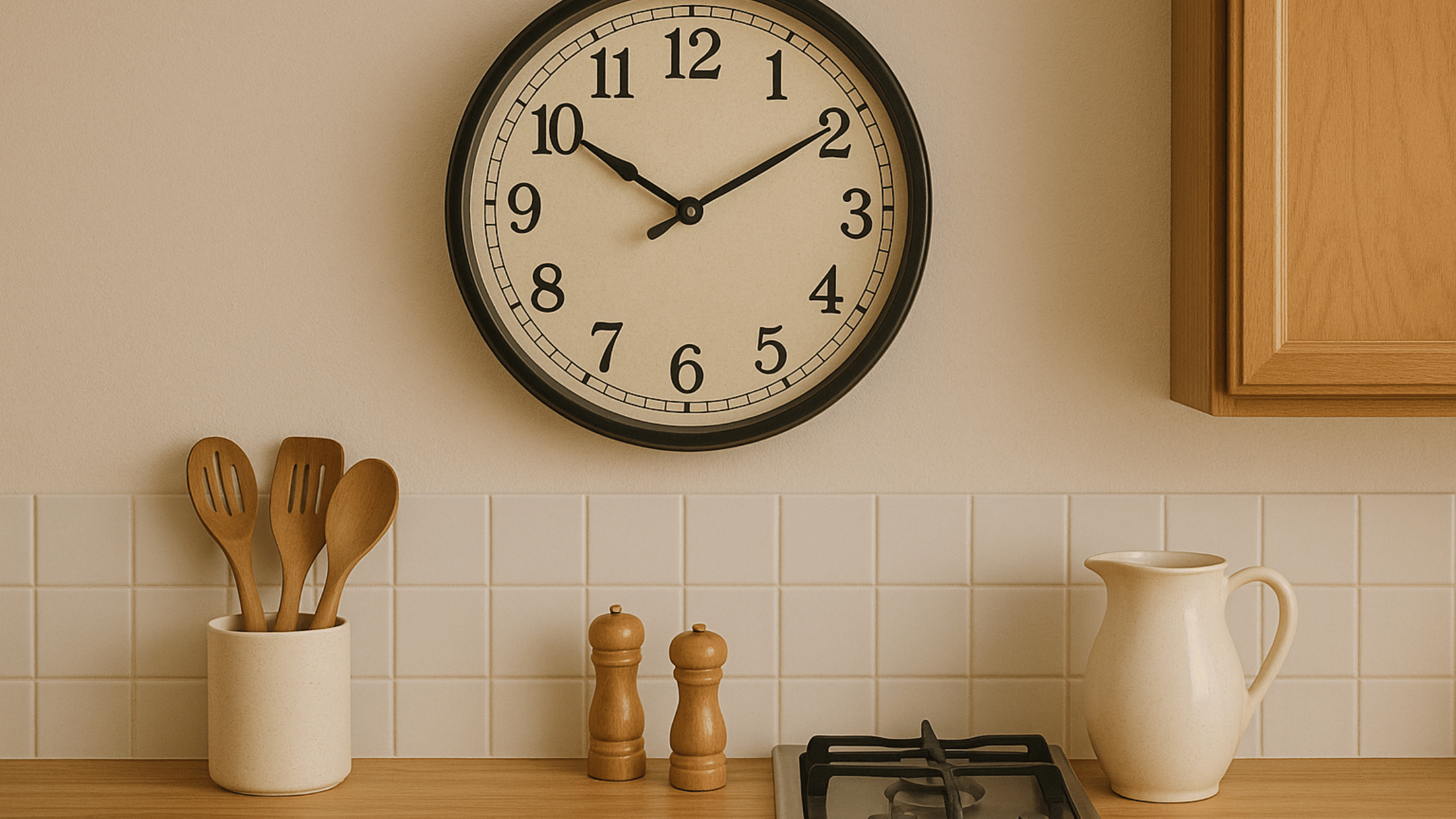Where to Place a Wall Clock in Your Kitchen
In the hustle and bustle of modern life, the kitchen remains the heart of the home—a space where we gather to share meals, stories, and precious moments. Amid this hub of culinary creativity and family connection, a wall clock serves as a quiet yet essential element.
This article will guide you in selecting the perfect spot for your kitchen clock, balancing both style and functionality. More than a mere accessory, a wall clock holds a unique significance in this key area of the home.
The Importance of a Kitchen Clock
The kitchen is more than just a place for meal preparation; it’s a space where time plays a critical role. A wall clock acts as a helpful guide, ensuring you keep track of time while balancing multiple tasks, like monitoring the perfect simmer for a stew, timing your chocolate cake in the oven, or remembering to take the bread out. Without a well-placed clock, the kitchen can quickly become chaotic, with precision giving way to improvisation and poor timing.
Far more than a simple timekeeper, a kitchen clock represents the balance between creativity and precision, order and spontaneity. Its placement is crucial to maximize its utility and aesthetic appeal, which is exactly what we’ll explore in the following sections.
Choosing a Style That Fits Your Kitchen
The perfect kitchen clock should complement your space both functionally and visually. Here’s what to consider:
1. Popular Clock Styles:
-
Modern: Clean lines, minimalist designs, and contemporary materials like metal and glass make these clocks ideal for streamlined, modern kitchens.
-
Vintage: Retro-inspired clocks with aged finishes and metal hands bring nostalgic warmth to your kitchen.
-
Rustic: Wooden clocks, often featuring Roman numerals, enhance the cozy atmosphere of farmhouse-style kitchens.
-
Industrial: Sturdy metal designs with vintage touches are perfect for loft-style or industrial kitchens.
-
Contemporary: Sleek, stainless steel clocks with bold shapes pair beautifully with contemporary interiors.
2. Achieving Style Harmony:
To ensure your clock blends seamlessly with your kitchen decor:
-
Color Coordination: Match the clock’s color to your kitchen’s palette for a cohesive look, or choose a contrasting hue to make a bold statement.
-
Material Matching: Select a clock with materials that complement other elements in your kitchen, such as wooden accents for a rustic feel or stainless steel for a modern touch.
-
Proportion: Ensure the clock’s size is appropriate for your wall space—not too overpowering, but not too small to notice.
Ideal Placement for Your Kitchen Clock
Where you position your clock can greatly impact its effectiveness and aesthetic appeal. Here are common options and their pros and cons:
a. On a Central Wall
-
Pros:
-
Optimal visibility from anywhere in the kitchen.
-
Makes the clock a focal point.
-
-
Cons:
-
Might compete with other wall decor or appliances for attention.
-
b. Above the Cabinets
-
Pros:
-
Utilizes vertical space in kitchens with limited wall space.
-
Adds a unique decorative element.
-
-
Cons:
-
Reduced visibility from lower angles.
-
May require frequent cleaning due to dust accumulation.
-
c. On a Shelf
-
Pros:
-
Offers flexibility to move the clock as needed.
-
Can be paired with other decor for a stylish arrangement.
-
-
Cons:
-
Visibility may be obstructed by other items on the shelf.
-
Requires a shelf with adequate depth.
-
d. Recessed into the Wall
-
Pros:
-
Creates a seamless and polished look.
-
Allows precise placement for optimal visibility.
-
-
Cons:
-
Installation is more complex and potentially costly.
-
Limited flexibility for repositioning.
-
Practical Considerations
While style and positioning are essential, practical factors also play a key role in determining where to place your kitchen clock.
1. Visibility from Work Areas
Ensure the clock is easily viewable from key work areas like countertops, stovetops, and sinks. This allows you to monitor time without interrupting your tasks.
2. Optimal Viewing Angle
The clock should be placed at eye level or in a spot that doesn’t require you to bend or strain your neck.
3. Safe Distance from Cooking Zones
Keep the clock away from heat, steam, and splashes to prevent damage. Ideally, it should be a few feet away from the stove or sink.
4. Lighting
Good lighting ensures the clock is easy to read. Position it in a well-lit area, either naturally or with artificial light.
5. Additional Features
Consider clocks with added functionality like timers or alarms, which can be particularly useful in the kitchen.
Decorative Tips for Kitchen Clocks
A kitchen clock can serve as both a functional and decorative piece. Here are some creative ways to integrate it into your kitchen:
-
Gallery Wall: Surround your clock with framed photos, art, or decorative kitchen utensils for a personalized look.
-
Floating Shelves: Place the clock on a shelf alongside potted herbs, cookbooks, or small decorative objects.
-
Color Coordination: Match the clock’s color with kitchen textiles or accents like dish towels and tableware.
-
Themed Clocks: Opt for clocks that align with your kitchen’s theme, such as coastal, farmhouse, or industrial.
-
Greenery: Pair your clock with indoor plants to add a fresh and vibrant touch.
Conclusion
The placement of your kitchen clock plays a significant role in both its functionality and aesthetic appeal. By considering style, positioning, and practical factors, you can find the perfect spot for your clock to enhance your kitchen’s decor and keep time in check.
For more tips and inspiration on home decor, subscribe to our newsletter! Receive our free e-book, "The Ultimate Guide to Wall Clocks," and stay updated on exclusive offers and ideas to elevate your home’s style.
Thank you for choosing CasaClock to bring elegance and practicality to your home!










